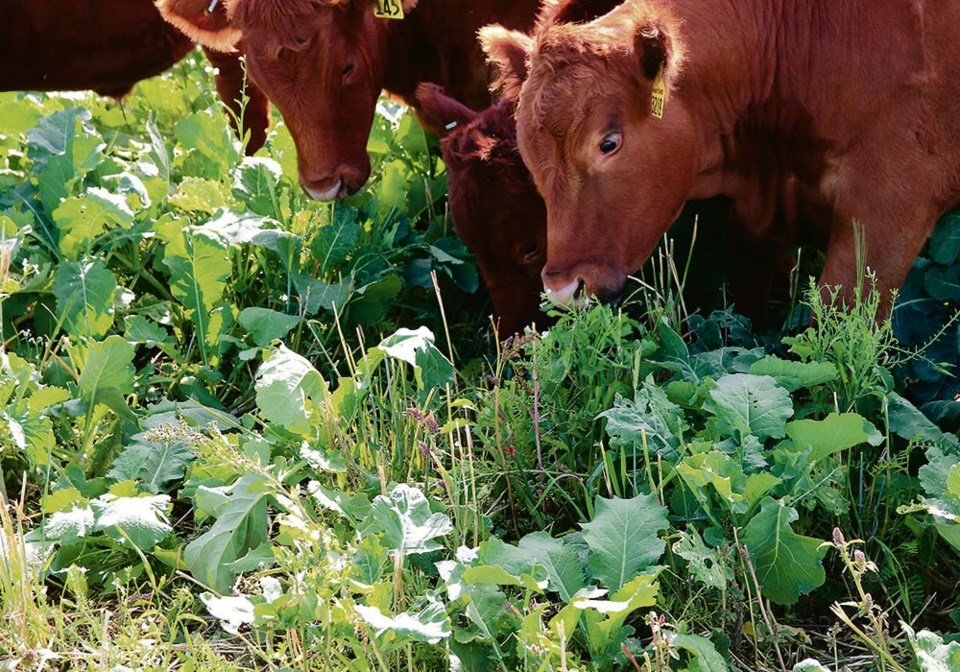WESTERN PRODUCER – Annual cover crops have another research receipt to support their purported soil health benefits.
But while those mixes can help cattle producers graze longer or recover some of the establishment cost by feeding livestock, cattle activity might not magnify soil health gains as much as many would hope.
The research comes from a four-year project spearheaded by Agriculture and Agri-Food Canada staff and sponsored by the Beef Cattle Research Council. The study set out to measure the benefits of integrated crop livestock systems and assess the impact of grazing forage cover crops in an annual crop rotation.
"Integrated crop-livestock (ICL) systems incorporate animals onto cropland when, most commonly, these practices are kept separate,” AAFC researcher Jillian Bainard said via email.
“In this project, we grew and grazed a diverse annual forage crop in an annual crop rotation. Other examples of ICL might include livestock grazing crop residues, grazing fall or winter crops in between cash crops, etc.”
The researchers found insufficient agronomic evidence to support animal inclusion on annual cropping land.
Weather might have played a role in the findings. The Prairies were gripped by abnormally dry growing conditions and drought during the study period. Lack of forage growth and feed shortages led to several rounds of government aid in Western Canada, as well as widespread herd destocking.
For Bainard, the potential impact of dry weather on her research points to the risks of ICL systems.
“I do think that it is important for farmers to be aware of the range of outcomes with ICL systems,” she wrote. “Though they have the potential to be very beneficial, there are also real risks and many factors to take into consideration.”
The project took place at four sites: two research farms and two producer operations in both Saskatchewan and Manitoba. Using three treatments at each site, researchers looked at soil health traits, productivity, ecosystem services and other effects of adding cover crops to an annual cropping system.
The three treatments included a control (a crop rotation of legume-cereal-oilseed-cereal); a simple mix of oats and peas; and a complex mix of forages that included oats, barley, millet, peas, hairy vetch, forage radish, hybrid brassica and phacelia.
“In the first year, we seeded a simple two-species mix, a complex eight-species mix and a conventional monoculture cash crop of peas. The two mixtures were grazed,” Bainard said.
“In the second year, all of these fields were seeded to forage barley with no grazing. In the third year, the simple and complex mixtures were grown and grazed again and the annual crop rotation treatment was seeded to canola.”
The fourth year saw all fields planted to wheat with no livestock.
Researchers were surprised to find the ICL system did little to enhance production of the following year’s crop.
“We predicted that the ICL system would benefit the production of the following crop, both through the animal activity and addition of animal wastes such as fertilizer as well as through the role of the diverse annual crops which included legumes and brassicas, which are expected to increase soil nutrients and organic matter.
“However, there was no real impact observed on the following crop and any changes to the soil that we observed appeared to be due to the complex forage mixture and not to the presence of livestock.”
Soil characteristics changed with the cropping treatment, but not when grazing was included. Cover cropped acres did show improved biological properties compared to the control.
When comparing results of the mixes, favourable growing conditions allowed the complex mixes to produce more dry matter biomass than the simple mixes. However, dry conditions saw low biomass in both.
Weed pressure was higher in the complex mix due to limited control options. It also resulted in higher soil ammonium, potassium and lower pH than the simple mix.
Soil biological properties (molecular microbial biomass, bacterial and fungal abundance and enzyme activity) were higher with the complex mix, which also had the highest soil water infiltration and featured slightly better soil aggregation compared to the simple mix and the annual crop rotation.
Grazing ultimately had no significant effect on soil chemical properties, said Bainard. Only bacterial abundance was influenced by grazing, but the pattern was not clear because that abundance was higher when grazing the simple mix and lower when grazing the complex mix.
In terms of nutrition, content including acid detergent fibre or ADF — a measure associated with digestibility — and neutral detergent fibre or NDF — a measure of total insoluble fibre contained in a ration — were similar in both mixes.
“Forage quality was also slightly better in the complex mix, with lower fibre and higher crude protein,” Bainard said.
Calcium, copper and iron were higher in the complex mix than in the simple one.
Cattle responses to the mixes varied.
“We found that yearling steers showed some preference for familiar forages when grazing the mixtures and they actually lost weight at the beginning, but over time they started eating more of the available forage and gained weight. Under a more intensive cow-calf grazing scenario, all crops were consumed.”
Bainard and other researchers will continue to investigate ICL systems. There’s still much to learn, the researcher noted.
“We are currently collaborating on a project called Integration of Livestock on Annual Crop Land, funded by the AAFC Sustainable Canadian Agricultural Partnership Agri-Science Program, Beef Cluster Component, with industry support from the Beef Cattle Research Council,” she said.
That project is headed by Emma McGeough and Yvonne Lawley of the University of Manitoba.
“This trial includes sites from B.C. to Ontario, so we will be able to observe these systems under varying climatic conditions.”




